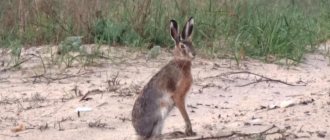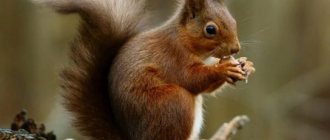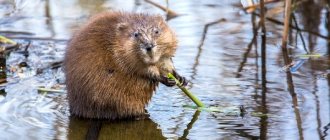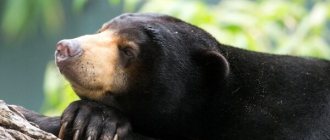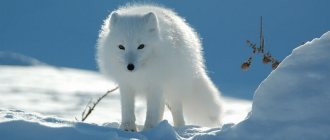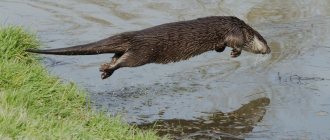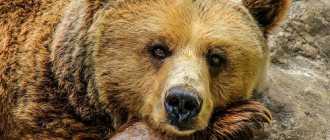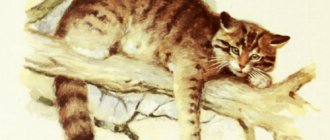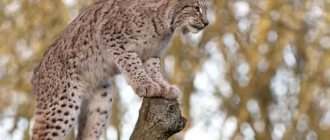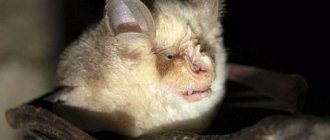- Wild animals
- >>
- Mammals
The large jerboa is an amazing animal that is famous for its unique running style. Another name for the animal is the earthen hare. These animals are the largest among all existing species of jerboas. The animal is distinguished by great caution, timidity and leads a rather hidden lifestyle. In this regard, many have no idea what kind of animal it is or what it looks like.
Origin of the species
The great jerboa belongs to the rodentia order and is a member of the family of five-toed jerboas. According to historical data, the ancestors of modern jerboas inhabited the planet almost from the time of its settlement. It has been scientifically proven that during the Oligocene period they actually already existed on our planet, and this is 33 - 24 million years ago!
Presumably, the ancient predecessors of jerboas migrated from Asian territory to the territory of northern Africa, as well as to Europe. Today, there are practically no representatives of this species left in Europe. Externally, jerboas are very similar to ordinary gray mice. About five dozen of these amazing animals are found in nature.
Habitat and lifestyle of jerboas
An interesting question is where the jerboa lives. Rodents are distributed everywhere, including Asian countries, the European part of the continent, Altai and the banks of the Ob River. Jerboas prefer to settle in burrows, which they build themselves.
Representatives of this family are characterized by a solitary lifestyle, searching for a mate only during the breeding season.
The domestic jerboa is a favorite of families with children. It has a calm, peaceful character, but requires a careful approach to maintenance and care.
Description
The great jerboa is the largest of the jerboas. It has a relatively short body (18.7-26 cm long); the tail is 1.3 times longer than the body (25-30.5 cm). Body weight is more than 300 g. The head is rounded with a well-defined cervical interception. The muzzle is slightly elongated, but wide, ending in a snout. The ears are relatively short, 57-59 mm high. The feet are long, reaching 45% of the body length. The hind legs of these rodents are long and strong. With their help, jerboas can jump up to three meters! This is 20 times the length of the animal’s body.
The color of the upper back varies from brownish-ochre or brownish-gray to pale sandy. The cheeks are light, almost white. The throat, chest, abdomen, forearms, and inner thighs are pure white. The outer side of the thighs is rusty-yellow, with a transverse white stripe running along them. The tail "banner" is two-colored with a black base and a white tip, well developed, shaped like a bird's feather.
Geographical dimorphism is characteristic: towards the south, the ears of jerboas become longer, and the color of the back becomes lighter from north to south and from west to east.
Where does the big jerboa live?
- long eared hedgehog
- Cross spider
- Reptiles
- 72 facts about plants
- Animals of Siberia
- 35 facts about giraffes
This representative of the family of five-toed jerboas lives in the steppe zones. A hundred years ago, these animals lived all the way from the west of Ukraine to the autonomous zone of China. Today, the animal’s habitat has been significantly reduced due to the destruction of its natural habitat by humans.
Geographical distribution zones of the great jerboa:
- territory of Eastern Europe;
- Kazakhstan;
- western regions of Siberia;
- the foot of the Tien Shan Mountains;
- the foot of the Caucasian mountain ranges;
- northern regions of the Black Sea coast;
- northern regions of the Caspian Sea;
- the foot of the Altai mountains.
The areas chosen for living are steppes and forest-steppes. They avoid plowed lands used for agricultural land. In such territories, jerboas cannot create a full-fledged home for themselves. They prefer areas with hard ground. You can also often find a large jerboa in the coastal areas of salt water bodies and steppe rivers. Settlement in mountainous areas is typical. Individuals can rise to a height of up to one and a half thousand meters above sea level.
Large jerboas love flat areas with sparse vegetation, meadows, and pine forests. They are considered unpretentious animals in terms of climate and weather, as well as natural conditions.
What does the big jerboa eat?
Large jerboas are considered herbivores. It is noteworthy that the appearance of the tail indicates the abundance of food, health and condition. If the tail is thin and the vertebrae are visually visible, the animal is exhausted and lives practically from hand to mouth. If the tail looks round and well-fed, the animal does not experience a lack of food. Every day an animal needs to consume at least 50-70 grams of food, depending on its weight.
The basis of the diet of a large jerboa is:
- Cereals;
- Insect larvae;
- Fruits;
- Seeds;
- Roots of various types of vegetation.
It is noteworthy that these small animals do not drink water. They consume the required amount of liquid from vegetation. Jerboas are able to travel long distances in search of food. They move mainly along previously surveyed paths. Capable of walking up to ten kilometers. Animals love to eat goose onions, seed peas, steppe bluegrass, melons, and watermelons.
Animals are not very picky about food. In the absence of their favorite ingredients, they can eat almost anything that comes their way.
They are considered a very important part of the natural habitat in which they live. They distribute seeds throughout the territory of their movement and control the number of insects in this area. However, at the same time they can be carriers of dangerous infectious diseases. Diet can vary significantly depending on the season. In spring, they prefer to eat young shoots and lush green vegetation. If there are agricultural areas nearby, they dig up the fields in search of seeds planted in the ground.
Behavior
The large jerboa leads a solitary nocturnal lifestyle. During the day, he hides in an underground shelter, which he digs himself. Near the northern borders of its range, the animal often prefers to use abandoned burrows of ground squirrels (Citellus).
The rodent builds different burrows depending on the time of year. It digs long horizontal corridors up to 6 m long, which end in a sharp depression into the nesting chamber, located at a depth of 60-120 cm in summer and 150-250 cm in winter.
The entrance to the shelter is clogged with an earthen plug during daylight hours. Several emergency exits branch off from the corridor, ending in close proximity to the soil surface. The ball-shaped nest is located in the nesting chamber and is lined on the inside with dry grass, mosses and scraps of fur. In the winter shelter there may be 2-3 nests at different depths.
In spring and autumn, the jerboa builds temporary shallow shelters directed at an angle into the ground. The main tool for digging holes is the front teeth (incisors); the paws play a secondary role in this matter. The excavated soil is often moved with the nose, which is used as a snout for pigs. The diet consists of food of plant origin.
A favorite delicacy is goose onion bulbs (Gagea). In its absence, the animal likes to feed on cereal grains or the bark of shrubs. He can be content with any green grass and plant seeds. The earth hare periodically supplements its vegetarian menu with small insects and land mollusks.
During the night, the eared creature travels about 4 km in search of food. With the onset of the first frost, the large jerboa goes into hibernation and wakes up at the end of March or early April. After waking up, his ears hang down to his sides for a while until the blood vessels and muscles work again.
During the winter, the body weight of the jerboa decreases by almost 2 times due to accumulated fat reserves.
Features of character and lifestyle
The large jerboa is a solitary animal. They tend to be most active at night. During the daytime, they mostly hide in made shelters - minks. They rarely leave them during daylight hours. Jerboa burrows are horizontal corridors 5-6 meters long. At the end of the corridor there is an extension in the form of a nesting chamber.
In the northern regions, gophers often occupy vacant houses. The depth of the shelter is determined by seasonality. In summer and spring, holes are dug at a depth of 50-110 centimeters, in winter - 140-220 centimeters. During daylight hours, animals cover the entrance hole to their shelter with earth. The long tunnel has several spare entrance holes that open almost on the surface of the earth.
The main role in the construction of shelters belongs to the front incisors. The limbs perform an auxiliary function. The excavated soil is moved with the nose, in the same way as in pigs. Large jerboas hibernate. They hide in a hole to hibernate with the onset of cold weather and the first frosts. Hibernation ends at the end of March.
Fat reserves concentrated in the tail area allow you to endure the winter period. During this period, some individuals lose up to 50% of their body weight. It is noteworthy that after waking up, the animals' ears droop. They rise only when blood circulation and muscle tone are restored.
Jerboas tend to lead a solitary lifestyle. It is noteworthy that they take root well in captivity. Cases of domestication are common, and sometimes a person gets two or more individuals that get along well with each other. Jerboas move exclusively on their hind limbs. They trot and can move by pushing off alternately with one and the other lower limbs. The tail maintains balance and acts as a rudder. Jerboas are capable of running very fast.
They are considered one of the fastest runners. They reach speeds of up to 50 km/h, and are able to run at this pace for more than two kilometers. It is characteristic that large jerboas hold records for high jumps. With their height, they jump up to three meters in height, which is almost ten times the length of their own body. Animals are naturally endowed with acute hearing and sense of smell.
general characteristics
Jerboas do not grow more than 27 cm, the smallest representatives do not exceed five cm. The weight of babies is from 100 to 350 g. The tail of jerboas is longer than the body, on average the length can reach 7 or 30 cm depending on the species. The long tail plays an important role during the movement of animals; it helps them balance when running and suddenly change direction. A raised tassel also serves as a signal of danger and alertness.
The jerboa's tail contains a reserve of fat, which is consumed during hibernation or the hungry period.
The body of jerboas is relatively short compared to the overall size. The length of the hind limbs is several times greater than the size of the front legs. Very rarely, jerboas use their forelimbs when walking, but most representatives of the species use only their hind limbs.
During their rapid movement, jerboas make ricocheting jumps, which, depending on the species, can reach 2–3 meters, which is hundreds of times the size of the animals.
Jerboas are capable of reaching speeds over short distances of up to 40 km/h. The faster the speed, the longer the jump.
The unique structure of the hind limbs helps to develop such speed. The three metatarsal bones are fused into one, which is called the tarsus; the lateral toes are either absent or less developed than the rest.
It has been noted that African jerboas have three-toed feet, while Asian species have five-toed feet. Each toe has well-developed claws; they are longer on the hind limbs than on the front limbs. In desert species, a kind of “brush” of hard hair grows on the foot, which provides a large area of support when moving on the sand and protects the foot from burns.
The head is large with a rounded, blunt or elongated muzzle. The neck of the animals is shortened, so it is almost invisible. In some representatives of the species, the cervical vertebrae are fused, which is why the body and head seem inseparable. The ears are large, round in shape; in some species the auricle grows together at the base into a tube.
The eyes, like those of all nocturnal inhabitants, are large and round in shape. Jerboas have very sensitive vibrissae, which are sometimes equal in size to the total length of the body.
Depending on the species, desert rodents may have 16 or 18 teeth. Surprisingly, when digging holes they use their teeth, and only push back the soil with their paws.
The fur of jerboas is soft and thick. The main color is uniform from brown to light sand. The chest and belly are white or painted the same color as the back.
Sex differences are mild. The color and body size of animals of different sexes are practically the same.
Social structure and reproduction
The mating period begins with the end of hibernation. The beginning of this period is considered to be the end of March, the beginning of April. The mating period continues until autumn. Under favorable conditions, jerboas are capable of producing offspring up to three times a year. This fecundity allows for the rapid restoration of endangered populations in some regions. Pregnancy lasts a short period of time - 25-27 days. One female is capable of giving birth to from 1 to 6-7 babies. Most often, offspring appear in the spring.
The cubs spend the first one and a half to two months in a shelter with their parents. At the end of this period, they begin to lead a separate lifestyle. The cubs understand that it is time for them to separate from their parents when the female becomes aggressive and no longer shows concern. The signal for such behavior is a lack of space in the burrow, as well as a significant increase in the weight of the offspring. Individuals that have reached 5-7 months of age are considered sexually mature. The female takes on the bulk of the care for the offspring.
Females prepare a place for birth by digging a separate burrow. The cubs are born completely helpless. They see nothing, they have no hair. Outwardly, they resemble baby rats.
Natural enemies of the great jerboa
Under natural conditions, these small rodents have many enemies.
Natural enemies:
- Reptiles;
- Snakes;
- Predator birds;
- Some species of lizards;
- Wolves;
- Lynx;
- Foxes.
Despite the fact that jerboas lead a hidden lifestyle and only come out at night, they often become prey to predators. The greatest danger to jerboas is posed by snakes, as well as owls, which hunt mainly at night. Rodents have excellent hearing and a keen sense of smell. Thanks to this, they are able to sense danger when it is still far away. Feeling a threat, the animals quickly run away. Special shelter burrows help them avoid danger.
Human activity is rapidly reducing animal populations. The development of territories and the destruction of the natural habitat of rodents leads to the destruction of animals.
Life cycle
The large jerboa emerges from hibernation in mid-March-April. Characterized by one highly extended breeding season, whose peak occurs in April-June. There are 1-2 broods per year; pregnancy lasts about 25 days. The litter ranges from 1 to 8, usually 3-6 cubs. They live with the female for up to 1.5 months. Sexual maturity is reached in the 2nd year of life. The maximum life expectancy in nature is up to 3 years.
In autumn, with the onset of constant frosts, jerboas go into hibernation. This usually happens in September, less often in October. The duration of hibernation in different regions ranges from 4 to 6-6.5 months; may be interrupted during thaws. Large jerboas do not store food; before hibernation they become very fat, sometimes doubling their body weight.
Guarding the Great Jerboa
In order to preserve the species, a set of measures is being developed to increase the population size. In the regions where the rodent lives, it is listed in the Red Book. In this area, development of territories, plowing of land, and grazing of livestock are prohibited.
The large jerboa is considered an amazing animal. Many people successfully start them at home. They quickly get used to new conditions and become tame.
Population and species status
Photo: Baby large jerboa
In general, it cannot be said that the rodent species is on the verge of extinction. However, on the territory of Russia and Ukraine, these animals have been practically exterminated. In many regions of Russia, the large jerboa is listed in the Red Book: Moscow, Lipetsk, Tambov, Nizhny Novgorod regions. It has been assigned the status of a vulnerable species.
Keeping a large jerboa in captivity
Keeping this cute and active animal at home is quite troublesome. He should have plenty of space to run and jump. Lack of physical activity leads to physical inactivity and weakened immunity. The animal is very clean, loves to clean its fur and chooses its own place for the toilet. It is simply impossible to force him to a place where he will relieve himself.
Despite all the efforts of the owner, the earthen hare remains wild. He can approach your hands and even allow himself to be stroked, but you cannot call him tame. Any communication with a person leads to stress, especially during the daytime.
Jerboas are kept in the largest enclosure that can be placed in an apartment. The height of the enclosure should be at least 1 m, as they can easily jump up to 50 cm and can hit the low-lying lid. Items of artificial origin must not be used inside. A rodent will chew any product, and if plastic gets into its body it will inevitably lead to death.
You cannot keep several animals together. They are very aggressive towards their fellow tribesmen and will certainly get into a fight.
A layer of soil on which grass has been previously grown is laid out at the bottom of the cage or enclosure. You can limit yourself to a thick layer of sand. It is unacceptable to use hard ground, which leads to injuries to the limbs. Be sure to have clean food bowls and drinking bowls with fresh water.
It is recommended to put roots, twigs and dry grass in the cage. From these the jerboa will be able to build a nest for itself. The main thing is that he has a shelter where he can hide and sleep.
At the first opportunity, freedom-loving animals escape from captivity and hide in a secluded place. At night, they are able to gnaw a hole in concrete to a depth of 20-30 cm or up to 45-50 cm in a brick wall and hide in it.
Feed your pet a mixture of grains, fruits and vegetables. It is useful to feed pumpkin seeds, watermelon, sunflower, carrots, beets, apples, pears, potatoes, willow branches and fruit trees. Feed crickets, grasshoppers, mealworms and other small insects regularly.
With good care, a large jerboa can live in captivity for up to 4-5 years.
Video
Interesting facts about the animal
The jerboa, in addition to the main hole, has several special protective shelters. If a predator begins to pursue the animal, it quickly moves towards such a hole and hides there. The escape trajectory resembles a zigzag. The most decisive moment is that the body turns to the left, and the tail makes a deceptive movement to the right.
There are 50 species of jerboas on the planet, but only three of them adapt to living at home. This is a large, small and hairy jerboa.
Ears make up two-thirds of the animal's body. The ground hare is considered the longest-eared creature on the planet. Thanks to this interesting feature, it is able to perceive the weakest sound waves.
The animals are very clean, and can clean themselves up to 30 times during the night. Young individuals cannot jump until they are three months old. Full maturity occurs at 2 years. In captivity, animals live up to four years.
Still have questions or have something to add? Then write to us about it in the comments, this will make the material more useful, complete and accurate.
The great jerboa (lat. Allactaga major) is the largest representative of the jerboa family (Dipodidae).
This medium-sized rodent is also called the ground hare.
If necessary, he is able to run a distance of up to 2 km at a speed of up to 50 km/h, making jumps up to 3 m in length, which is 10 times his own body. During such a run, the animal appears to be flying above the ground, pushing off with one or the other paw and without making sharp turns.
The species was first described in 1792 by Scottish naturalist Robert Kerr.
